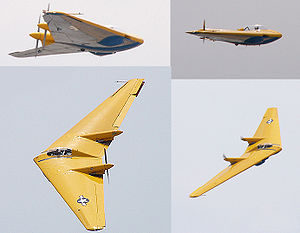Northrop N-9M Videos
|
Loading...
|
|
Northrop N-9M
Northrop N-9M
Picture - The restored N-9MB Flying Wing at the Planes of Fame Air Museum
Role: Prototype
Manufacturer: Northrop Corporation
Designed by: Jack Northrop
First flight: 27 December 1942
Status: Prototype only
Primaryuser: United States Air Force
Number built: 4
The Northrop N-9M was a one-third scale aircraft used for the development of the Northrop XB-35 and YB-35 Flying Wing long-range bomber program. First flown in 1942, the N-9M (M for Model) was the third in a lineage of all-wing Northrop aircraft designs that began in 1929 when Jack Northrop succeeded in early experiments with his single-prop, twin-tailed, stressed metal skin "Flying Wing" monoplane, and a decade later, the dual-prop N-1M of 1939-1941. Northrop's pioneering all-wing aircraft would lead Northrop-Grumman many years later to eventually develop the advanced B-2 Spirit stealth bomber, which debuted in Air Force inventory in 1989.
Design and development
On 30 October 1941, the preliminary order for development of the B-35 Flying Wing bomber was confirmed, including engineering, testing, and - most importantly - a 60ft (18m) wingspan, one-third scale aircraft, designated N-9M. It was to be used in gathering data on flight performance and for familiarizing pilots with the program's radical, all-wing design. The first N-9M was ordered in the original contract, but this was later expanded to three test aircraft in early 1943. A fourth was ordered a few months later and would incorporate flight test improvements, including different, more powerful engines. They were designated N-9M-1, -2, -A, and -B, respectively.
The N-9M framework was partially constructed of wood to reduce its overall weight. The wings' outer surfaces were also skinned in a strong laminated plywood. The central section (roughly equivalent to the fuselage) was made of tubular steel. The aircraft was powered by two Menasco C65-1 engines, driving twin-bladed propellers. The original engines were 290hp (216); the N-9MB later upgraded to 400hp (298kW) Franklin engines.
Operational history
The first flight of the N-9M occurred on 27 December 1942 with Northrop test pilot John Myers at the controls. During the next five months, 45 flights were made. Nearly all were terminated by mechanical failures of one sort or another, the Menasco engines being the primary source of those problems. After roughly 22.5 hours of accumulated flight time, the first N-9M crashed approximately 12miles (19km) west of Muroc Army Air Base on 19 May 1943. The pilot, Max Constant, was killed as he attempted to recover the aircraft from a right-hand, 60° nose-down spin. The investigation found that Constant had suffered control reversal, the control column had been pressed against his chest during his recovery attempt from the steep spin, preventing him for parachuting to safety. Steps were taken to fix this problem and prevent it from happening on other N-9M test aircraft.
When Northrop's Flying Wing bomber program was canceled, all remaining N-9M flight test aircraft, except for the final N-9MB, were scrapped. For more than three decades, it slowly deteriorated until the Chino, California Planes of Fame Air Museum acquired the aircraft in 1982 and began the labor intensive restoration process. For the next two decades, former Northrop employees and other skilled volunteers, slowly returned the N-9MB to last flight configuation. Since 2001, the yellow-and-blue Flying Wing has been exhibited, with flight demonstrations at several airshows every year.
In April 2006, the N-9MB suffered an in-flight engine fire. The aircraft was landed safely with limited damage. Donations to the museum were solicited for its repair, and the aircraft was fully repaired to flight status. It was once again flown during the annual Chino airshow on 15-16 May 2010.

Picture - The restored N-9MB Flying Wing being flown at Planes of Fame's 2004 airshow, Chino. The museum usually flies their one-of-a-kind Flying Wing at several airshows per year.
Specifications (N-9M)
General characteristics
Crew: one, pilot. (The N-9MB also had an observers seat. This was achieved by removal of the 50 gal fuel tank located behind the pilot)
Length: 17.79ft (5.4 m)
Wingspan: 60ft 0 in (18.3 m)
Height: 6.58ft 0 in (2. 00 m)
Wing area: 490ft² (45.5 m²)
Empty: 5,893 lb (2673kg)
Loaded: 6,326lb (3,175kg) 6,818 (N-9MB)
Powerplant: 2x Menasco C6S-4, 275 hp (205kW) each
Powerplant: (N-9MB) 2x Franklin XO-540-7, 260hp each
Airfoil: NACA 65-019
Performance
Maximum speed: 258mph (415km/h)
Range: 500mi (805km)
Service ceiling: 21,500ft (6,555 m)
Related development:
Northrop N-1M
Northrop YB-35
Northrop YB-49
Comparable aircraft:
Horten Ho 229
Bibliography
Coleman, Ted. Jack Northrop and the Flying Wing: The Real Story Behind the Stealth Bomber. New York: Paragon House, 1988. ISBN 1-55778-079-X.
Donald, David, editor. "Northrop Flying Wings", Encyclopedia of World Aircraft. Etobicoke, Ontario: Prospero Books, 1997. ISBN 1-85605-375-X.
Maloney, Edward T. Northrop Flying Wings. Corona del Mar, California: World War II Publications, 1988. ISBN 0-915464-00-4.
O'Leary, Michael. "Northrop's Flying Sorcery". Aeroplane, Volume 35, Number 6, Issue 410, June 2007. pp.62-64.
O'Leary, Michael. "The Shape of Wings to Come". Aeroplane, Volume 35, Number 6, Issue 410, June 2007, pp.65-68.
O'Leary, Michael. "Wings of Northrop, Part Two". Air Classics, Volume 44, Number 1, January 2008, Challenge Publications, Inc. ISSN 0002-2241. (Heavily illustrated, authoritative N-9M article.)
New 'Flying Wing' Plane Hailed as Great Advance In Aviation. "The Baltimore American" newspaper, Section E, 9 February 1930. (Front-page feature article with two photos reporting on Northrop's flights with his first Flying Wing monoplane.)
Pape, Garry and John Campbell. Northrop Flying Wings: A History of Jack Northrop's Visionary Aircraft. Atglen, PA: Schiffer Publishing, Ltd., 1995. ISBN 0-88740-689-0.
Wooldridge, E. T. Winged Wonders: The Story of the Flying Wings. Washington, D.C.: Smithsonian Institution Press, 1983. ISBN 0-87474-966-2.
Living Warbirds: The best warbirds DVD series.
Source: WikiPedia